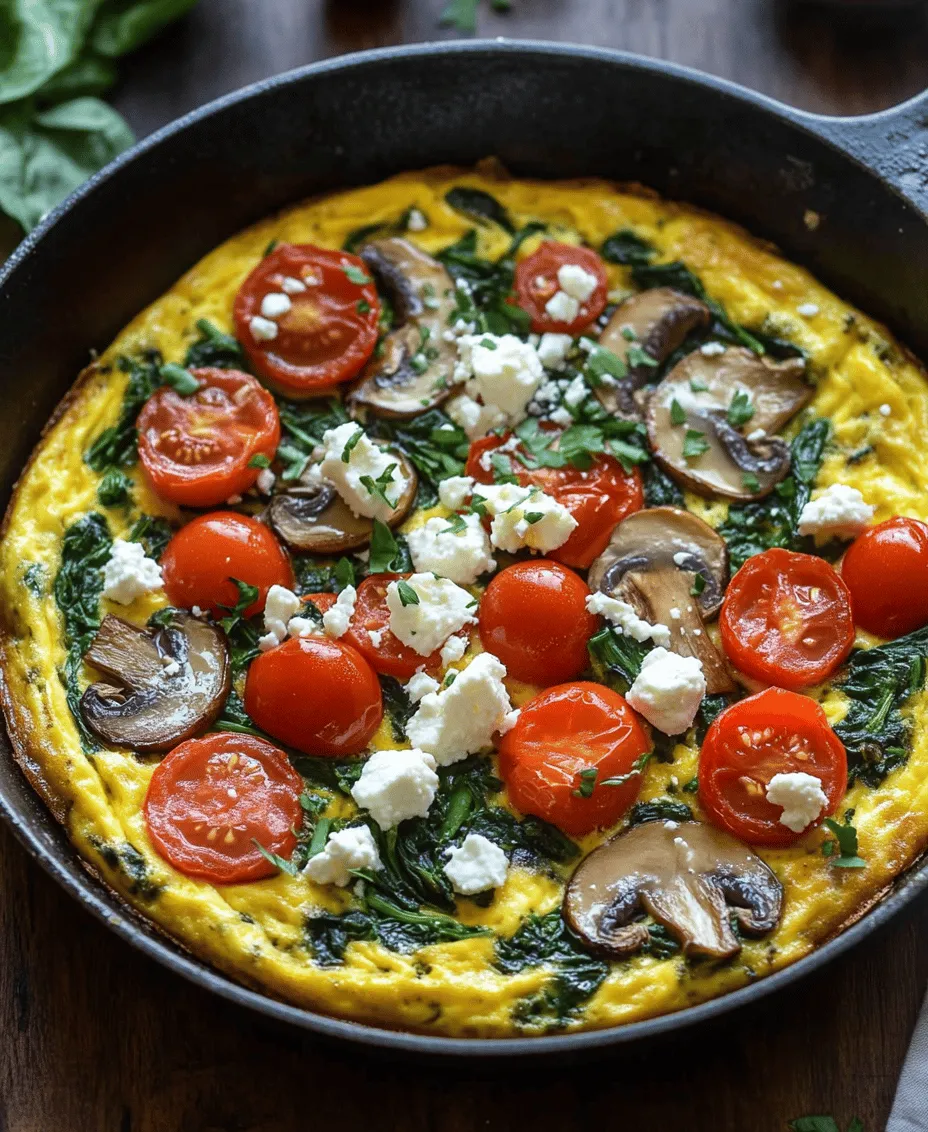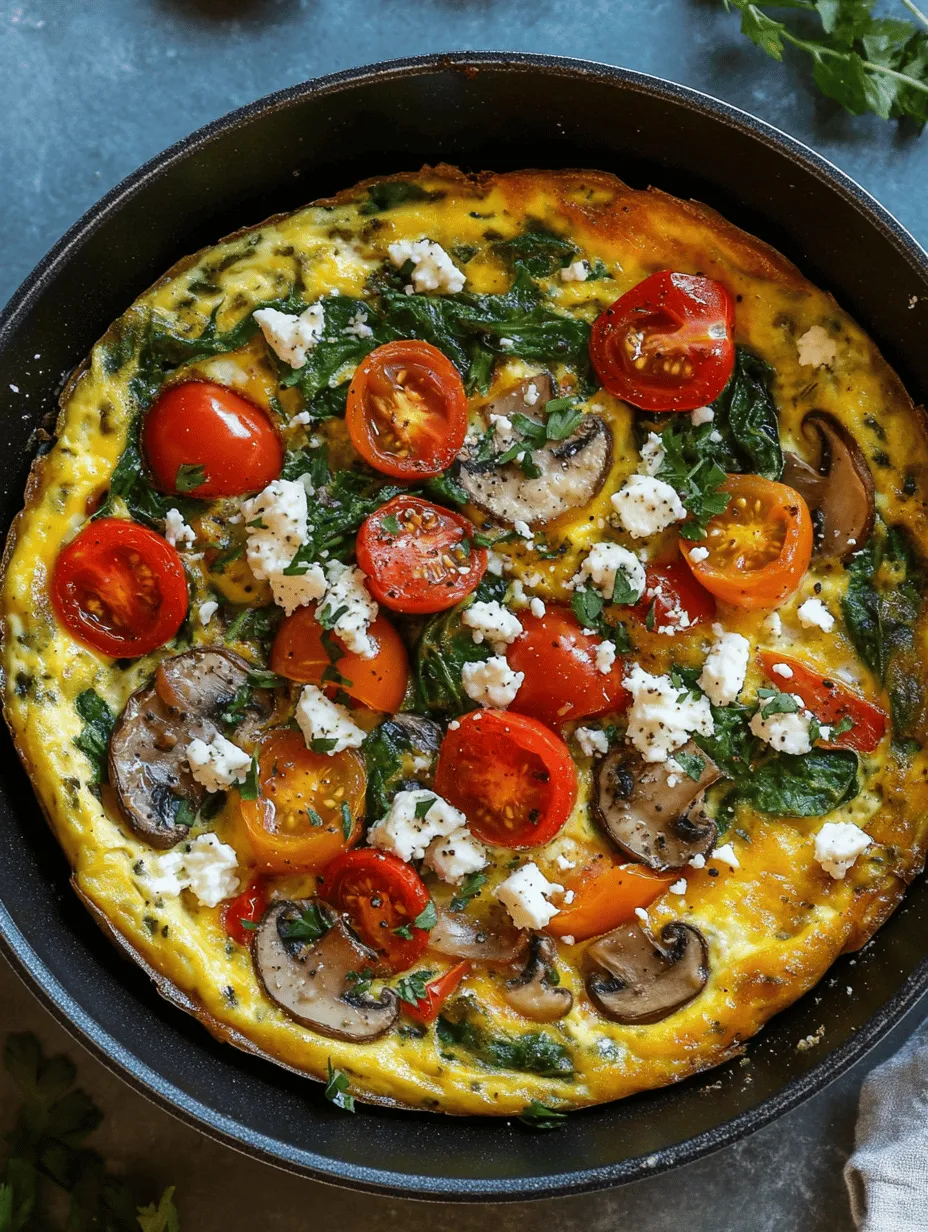Introduction
The frittata is a quintessential dish that embodies versatility and flavor. With roots in Italian cuisine, this baked egg dish can be customized with a variety of ingredients, making it perfect for breakfast, brunch, or even dinner. Its adaptability means that you can incorporate whatever vegetables, meats, or cheeses you have on hand, making it a go-to solution for busy weeknights or lazy weekends. In this article, we will explore the perfect frittata recipe, its origins, nutritional benefits, and endless variations to suit your taste. Whether you’re a seasoned cook or a kitchen novice, this guide will help you master the art of frittata-making.
Understanding the Frittata
The Frittata: A Brief History
The frittata has a rich history rooted in the heart of Italy, where it originated as a simple, hearty dish that utilized leftover ingredients. The term “frittata” is derived from the Italian verb “friggere,” meaning “to fry.” Traditionally, it was a straightforward combination of eggs and whatever vegetables were available, cooked slowly on the stovetop before being finished in the oven.
Over the years, the frittata has evolved into a beloved dish that transcends its humble beginnings. Unlike its close relatives—the omelet and quiche—the frittata is distinguished by its inclusive approach to ingredients. While an omelet is typically folded around fillings and a quiche is baked in a pastry crust, a frittata combines all its components into one cohesive dish. This method not only simplifies preparation but also allows for a more even distribution of flavors.
As the frittata gained popularity, it found its way into kitchens across the globe, adapting to local tastes and ingredient availability. From the classic Italian version to modern interpretations featuring global flavors, the frittata remains a versatile favorite in both home and professional kitchens.
The Nutritional Benefits of a Frittata
One of the standout features of a frittata is its nutritional profile, making it a smart choice for a balanced meal. The primary ingredient—eggs—are a powerhouse of protein. A single large egg contains about 6 grams of protein, along with essential vitamins and minerals like vitamin B12, riboflavin, and selenium.
In addition to eggs, frittatas often include an array of nutrient-rich vegetables, such as spinach, bell peppers, and tomatoes. These ingredients contribute valuable dietary fiber, vitamins, and antioxidants that support overall health. By incorporating a variety of colorful vegetables, you can create a visually appealing dish that is also packed with nutrients.
Furthermore, frittatas can be tailored to meet various dietary preferences and restrictions. They can easily be made gluten-free, and by substituting dairy or using plant-based cheese options, they can also cater to vegan diets. The healthy fats derived from olive oil or cheese add richness without compromising health, making the frittata a well-rounded meal choice.
Essential Ingredients for the Perfect Frittata
To achieve the perfect frittata, it’s crucial to use high-quality ingredients. Here’s what you’ll need to gather for this delightful dish:
Key Components of the Recipe
1. Eggs: The foundation of the frittata. Opt for fresh, organic eggs whenever possible for the best flavor and nutritional benefit.
2. Dairy Choices: The type of dairy you choose can affect the creaminess of your frittata. Whole milk, heavy cream, or even plant-based milk alternatives can be used to enhance the texture. Adding cream will yield a richer frittata, while milk will keep it lighter.
3. Vegetables: Fresh vegetables are essential for flavor and nutrition. Popular choices include:
– Spinach: Adds a mild, earthy flavor and is rich in iron and vitamins.
– Cherry Tomatoes: Provide sweetness and a burst of flavor.
– Bell Peppers: Add color and a crunchy texture.
– Mushrooms: Provide umami and a hearty element.
– Onions: Enhance overall flavor with their natural sweetness.
4. Cheese: Cheese brings an additional layer of flavor and creaminess. Consider using:
– Feta: For a tangy kick.
– Goat Cheese: To add a creamy texture with a distinct taste.
– Cheddar: For a sharp, bold flavor.
5. Seasoning: Proper seasoning is key to elevating your frittata. Don’t overlook the importance of salt and pepper, but also consider adding fresh herbs like basil, parsley, or chives to brighten up the dish.
Step-by-Step Guide to Making the Perfect Frittata
Preparation Before Cooking
Before diving into the cooking process, it’s essential to prepare all your ingredients. Here’s how to get started:
1. Gather and Prep Ingredients: Start by collecting all your ingredients and tools. You will need a mixing bowl, a whisk, and an oven-safe skillet, ideally non-stick or cast iron for easy release. Chop your vegetables into bite-sized pieces and, if using cheese, crumble or grate it.
2. Importance of Using an Oven-Safe Skillet: Since the frittata is finished in the oven, using an oven-safe skillet is crucial. It allows you to cook the frittata on the stovetop until the edges are set and then transition it directly into the oven for a perfectly cooked center without transferring to another dish.
Cooking Process
Once your ingredients are prepped, follow these steps to make your frittata:
1. Preheat the Oven: Preheat your oven to 375°F (190°C). This ensures that the frittata cooks evenly.
2. Sauté the Vegetables: Heat a tablespoon of olive oil in your oven-safe skillet over medium heat. Add your chopped vegetables, starting with those that take longer to cook (like onions and bell peppers). Sauté until they are tender, about 5-7 minutes. If you’re using leafy greens like spinach, add them last, as they wilt quickly.
3. Whisk the Eggs: In a mixing bowl, whisk together your eggs and dairy of choice. Season with salt and pepper, and mix until well combined. You can also add any herbs you plan to use at this stage.
4. Combine Ingredients: Pour the egg mixture over the sautéed vegetables in the skillet. Gently stir to evenly distribute the vegetables throughout the eggs. Sprinkle your cheese of choice evenly over the top.
5. Cook on Stovetop: Allow the frittata to cook on the stovetop for about 3-5 minutes. This initial cooking helps to set the edges while the center remains slightly runny.
6. Transfer to the Oven: Once the edges are firm, transfer the skillet to the preheated oven. Bake for 15-20 minutes, or until the frittata is puffed and set in the middle. A toothpick inserted in the center should come out clean.
With these steps, you’ll be well on your way to mastering the art of frittata-making, setting the stage for a dish that is not only delicious but also endlessly customizable. Stay tuned for the next part of this guide, where we will delve deeper into variations, tips for achieving the perfect texture, and answers to common frittata-related questions.

Step 1: Preheating the Oven for Optimal Cooking
Before you dive into the exciting world of frittata creation, it’s crucial to preheat your oven to 375°F (190°C). This temperature ensures that the frittata cooks evenly and rises beautifully, forming that perfect fluffy texture that is the hallmark of a well-made frittata. Preheating the oven is not just a formality; it sets the stage for a delightful culinary experience. While the oven is warming up, you can focus your attention on the next steps of preparing your ingredients.
Step 2: Sautéing Vegetables: Tips for Achieving the Right Texture
The foundation of a delicious frittata lies in perfectly sautéed vegetables. Choose your favorites, such as bell peppers, zucchini, onions, and spinach. Start by heating a tablespoon of olive oil or butter in a non-stick skillet over medium heat.
1. Cut Vegetables Evenly: To ensure even cooking, chop your vegetables into uniform pieces. Smaller pieces will cook faster, while larger chunks will retain more texture.
2. Sauté with Care: Add the vegetables to the skillet in stages, starting with those that take longer to cook, like onions and bell peppers. Sauté them for about 5-7 minutes until they become tender. Follow with quicker-cooking vegetables like spinach, which should only take a couple of minutes until wilted.
3. Season Generously: Don’t forget to season your sautéed vegetables with salt, pepper, and any other preferred spices. This step enhances their flavor and makes them an integral part of the frittata.
Step 3: Whisking Eggs and Combining with Dairy
While your vegetables are sautéing, it’s time to prepare the egg mixture that will bind all your ingredients together. In a large mixing bowl, crack 6 large eggs and whisk them vigorously until they are well combined.
1. Add Dairy: For a creamier texture, add about 1/2 cup of milk or cream to the eggs. This will not only enhance the flavor but also contribute to the fluffiness of your frittata.
2. Season the Egg Mixture: Just like the vegetables, the egg mixture should be seasoned with salt and pepper. This is your opportunity to infuse flavor into the base of the frittata.
Step 4: Incorporating Cheese for Added Flavor
Cheese is a quintessential component of a frittata, adding creaminess and depth. Grate about 1 cup of cheese such as cheddar, feta, or mozzarella, depending on your flavor preference.
1. Mix the Cheese: After whisking the eggs and dairy, gently fold in the grated cheese. This not only incorporates it into the mixture but allows the cheese to melt perfectly during cooking.
2. Choose Wisely: Opt for cheeses that complement your vegetable selection. For example, goat cheese pairs wonderfully with sautéed spinach, while sharp cheddar enhances the flavor of bell peppers.
Step 5: Merging the Egg Mixture with Sautéed Vegetables
Now that both components are ready, it’s time to bring them together.
1. Combine: Pour the egg and cheese mixture directly over the sautéed vegetables in the skillet. Stir gently to ensure an even distribution of the vegetables throughout the egg mixture.
2. Cook on Stovetop: Let this mixture cook on low heat for about 5 minutes. This step helps set the edges of the frittata and gives it a nice crust.
Baking Techniques
Step 6: Cooking on the Stovetop: Achieving the Perfect Edge
To achieve that perfectly cooked edge, continue cooking on the stovetop. Using a spatula, gently lift the edges of the frittata to allow any uncooked egg to flow underneath. This technique ensures that the frittata is set but still has a soft center.
Step 7: Baking in the Oven: Timing for the Ideal Texture
Once the edges are set, transfer the skillet directly to the preheated oven. Bake for about 15-20 minutes, or until the frittata is puffed up and a knife inserted into the center comes out clean.
1. Keep an Eye on It: Every oven is different, so start checking for doneness at the 15-minute mark. You want a golden top with a slight jiggle in the center.
2. Broil for a Finish: For an extra touch, you can broil your frittata for the last 2-3 minutes to achieve a beautifully browned top. Just be cautious not to let it burn.
Step 8: Cooling and Serving: Presentation Tips
Once your frittata is done baking, remove it from the oven and let it cool for about 5 minutes. This helps it set further and makes slicing easier.
1. Slice and Serve: Use a sharp knife to cut the frittata into wedges. Serve warm or at room temperature; frittatas are versatile and can be enjoyed at any temperature.
2. Presentation: For a beautiful presentation, garnish with fresh herbs like parsley, chives, or basil. This not only adds color but also a fresh flavor that complements the dish.
Creative Variations to Try
Frittatas are incredibly versatile, allowing you to experiment with flavors and ingredients. Here are a few creative variations to inspire your next culinary adventure:
Vegetarian Options
– Substituting Different Vegetables: Embrace seasonal produce by swapping out vegetables based on what’s fresh. Asparagus in spring, tomatoes in summer, or root vegetables in fall can transform your frittata experience.
– Adding Herbs for Freshness and Aroma: Fresh herbs like dill, thyme, or oregano can elevate the flavors of your frittata. Add them into the egg mixture or sprinkle on top before serving for a pop of color and flavor.
Meat Lover’s Frittata
– Incorporating Proteins: For those who enjoy a heartier meal, consider adding cooked bacon, ham, or sausage. Just be sure to cook the meat beforehand and drain any excess fat before adding it to the egg mixture.
– Balancing Flavors with Vegetables: Complement the meat with vegetables that enhance its flavor. For instance, pairing sausage with sautéed onions and bell peppers creates a satisfying combination.
Global Inspirations
– Mediterranean Frittata: Incorporate ingredients like olives, sun-dried tomatoes, and feta cheese for a Mediterranean twist. The salty olives and creamy feta will bring a new dimension to your frittata.
– Mexican-Inspired Frittata: Add chorizo and fresh cilantro, along with diced tomatoes and jalapeños for a spicy kick. Serve with avocado or salsa for a complete Mexican breakfast experience.
Serving Suggestions for Your Frittata
A frittata can be a meal on its own, but pairing it with the right sides can elevate the dining experience.
Ideas for Pairing
– Side Dishes: Consider serving your frittata alongside a fresh salad. A simple arugula salad with lemon vinaigrette pairs beautifully, or crusty bread for dipping can add a delightful crunch.
– Beverage Pairings: A cup of freshly brewed coffee or tea complements the frittata perfectly. For a refreshing option, serve it with freshly squeezed juice or a light sparkling water.
– Garnishing Techniques: Fresh herbs can be a game-changer for presentation. Sprinkle chopped chives, parsley, or microgreens over the top of your frittata before serving for an elegant touch.
Conclusion
The perfect frittata is not only easy to make but also a canvas for creativity in the kitchen. With its rich flavors and delightful textures, this dish can easily become a staple in your meal rotation. From its humble beginnings in Italy to its modern interpretations around the world, the frittata offers endless possibilities for delicious meals that can be enjoyed any time of day. Embrace the versatility of the frittata, and let it inspire your culinary adventures. Whether you opt for a classic recipe or put your twist on it, this dish is sure to impress your family and friends, bringing joy to every table.


